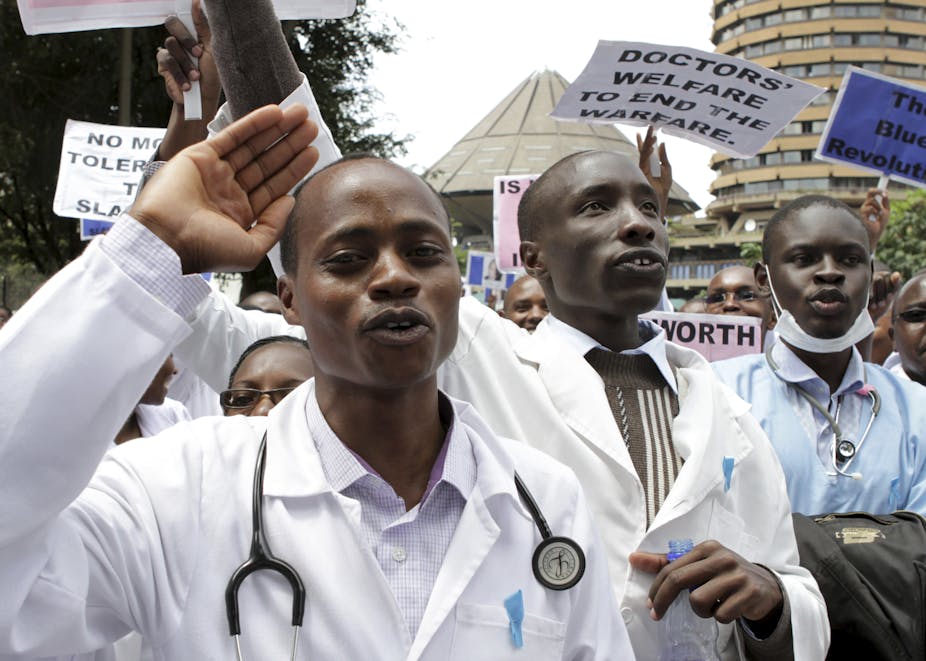Kenyan doctors have returned to work after a gruelling 100-day strike, but a pressing question lingers: what are the long-term implications of their action on Kenya’s creaking health service?
The doctors had gone on strike to push the government to implement a collective bargaining agreement signed in 2013. They ended the strike after reaching a deal with the government on salary increases of between 40% and 50% for all doctors in the public sector, signing of a collective bargaining agreement within sixty days and that there would be no victimisation of those who had been on strike.
A 40% salary increment is a formidable achievement for a trade union in Kenya: nonetheless other key issues that the union had raised were not fully addressed.
Doctors have resumed work. But the health facilities they work in remain unchanged. The long queues in public hospitals, insufficient supplies, lack of specialists in peripheral facilities and many preventable deaths are still a reality.
Moving forward, the health agenda should take centre stage in Kenya’s political and development debates to push for quality health care and ensure that the colossal health bills don’t continue to cripple Kenyans.
The end of the doctors’ strike should be viewed as a truce in the fight for better health care for all. Kenyans – including those in the health sector, the government, civil society and in communities – should make the best of it and heighten the level of cordial engagement to avoid a similar strike in future.
Unfinished business
The agreement to end the strike bears mixed fortunes for the heath sector. If implemented fully, it will form a good foundation for the government and doctors to pull together towards improved healthcare.
But the odds of this happening aren’t looking good. The process of implementing the return-to-work agreement has already hit speed bumps. This shows a lack of a goodwill which is likely to strain the relationship between the union and the employers.
This is a pity because the government has the opportunity to win the confidence and goodwill of the doctors’ union and other trade unions in the country by honouring the agreement. And both parties have a good opportunity to engage amicably during ‘peace-time’ which is preferable to negotiating during a strike.
The government needs to engage the union in major decisions that affect doctors. If this avenue is used properly, thorny issues can be sorted out in good time. This is especially important for key policy decisions on matters concerning human resource management and health facility infrastructure.
Over the coming weeks, both parties have an opportunity to reach a collective bargaining agreement which would be a major boost to the health sector in the country. The agreement is expected to streamline recruitment, equipping, training and retention of doctors in the public sector.
The question of industrial action
Another outcome of the strike is an awareness that the laws governing Kenya’s labour relations need to be aligned with the constitution.
The act, which predates the country’s current constitution, attempts to limit the freedom of workers to go on strike as defined in the constitution.
This is why many strikes in Kenya are declared unprotected by the courts which then issue orders to stop them, curtailing the freedom of employees to go on strike.
This issue is a common source of disagreement between trade unions and the courts and was a major point of contention in the doctors’ strike. It needs to be addressed to safeguard human rights and preserve the dignity of the courts.
The reality of public health facilities
The public had high expectations that the quality of health services would improve markedly once the strike was over.
But very little has changed at public health facilities which remain crowded, understaffed and poorly equipped.
Doctors need to continue persuading key decision makers to allocate more funds to the health docket to improve health infrastructure, equipment and supplies.
But doctors can’t bring about change on their own. Civil society and the general public needs to push elected leaders and public officials to fix the health care system.
And community members need to be encouraged to demand that local health centres are well staffed and equipped to provide basic health care services.

